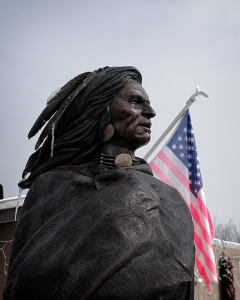 Photo by Mike Fisher at Flickr Creative Commons - The photographer notes in his comment: "The juxtaposition of the flag with this sculpture of an Indian made me think of Black Kettle, who was a Southern Cheyenne Indian chief. Black Kettle's people were camped on the Sand Creek Reservation in southeast Colorado in 1864 when a group of Colorado militia men attacked them. Black Kettle had often counseled peace with the white men and flew an American flag from his tipi. The soldiers attacked in spite of the flag and killed as many as 150 of Black Kettle's people. Black Kettle himself escaped across the creek, only to be killed a few years later in the Battle of the Washita River in Oklahoma."[/caption]
Photo by Mike Fisher at Flickr Creative Commons - The photographer notes in his comment: "The juxtaposition of the flag with this sculpture of an Indian made me think of Black Kettle, who was a Southern Cheyenne Indian chief. Black Kettle's people were camped on the Sand Creek Reservation in southeast Colorado in 1864 when a group of Colorado militia men attacked them. Black Kettle had often counseled peace with the white men and flew an American flag from his tipi. The soldiers attacked in spite of the flag and killed as many as 150 of Black Kettle's people. Black Kettle himself escaped across the creek, only to be killed a few years later in the Battle of the Washita River in Oklahoma."[/caption]
Laura Mirsky sent me this piece this morning, which both of us found moving. So often we think of restorative justice at the person to person level, but here's an example of community to community and nation to nation healing process, which must therefore take a different form.
Write Paula Palmer and Aya Medrud in the Boulder, Colorado Daily Camera:
The Restorative Justice movement teaches us that everyone involved in a crime or injustice (victims, perpetrators, and the community of people whose lives are touched and altered) needs healing and must participate in the healing process.
This year, the One Action One Boulder project has pointed to a gaping wound in the Boulder Valley, a wound that goes back 150 years. We do not like to think about it because it makes good people feel bad. Still, it is undeniable: we live on land stolen from the Arapaho and Cheyenne peoples, and we are all unconscious beneficiaries of the swindle. Our community needs healing. In the coming Thanksgiving season we have an important opportunity.
The story then recounts some of the dreadful history and notes: "Today Sand Creek is a National Historic Site commemorating the horrific massacre there of 160 unarmed Cheyenne and Arapaho women, children, and elders, who frantically waved the U.S. flag and white flags as they were gunned down."
According to the article, Cheyenne and Arapaho survivors were eventually banished from Colorado and no longer live in the state. But 14 years ago they initiated a healing process, and during this month's Thanksgiving holiday,
Cheyenne and Arapaho runners will complete a 170-mile Spiritual Healing Run/Walk from the Sand Creek Massacre site to Denver in honor of LaForce Lee Lonebear. This is how they describe the Run:
"The Sand Creek Massacre Spiritual Healing Run/Walk is a prayer. (It) is not a race. (It) is a commemoration for the victims and survivors of the massacre, and for healing ancestral homelands. (It) is led by an Eagle staff representing prayers of the spiritual leaders who had a vision of healing and reconciliation for the descendants of those killed at the Sand Creek Massacre site and for the future generations."
The Cheyenne and Arapaho have invited local communities to participate in a variety of ways, all of which can be found in the full article: Guest opinion: How does healing happen? - Boulder Daily Camera.
